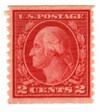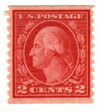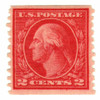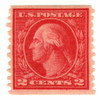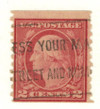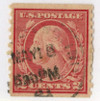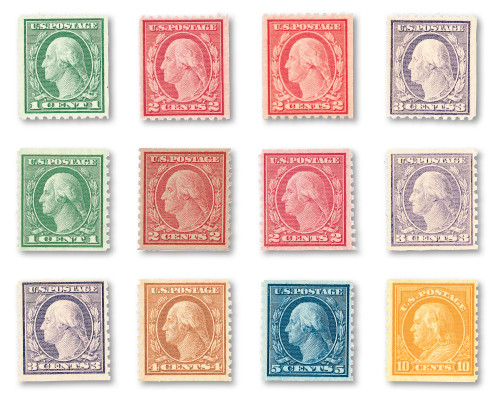
1917 2c Washington carmine, perf 10, type III
# 492 - 1917 2c Washington carmine, perf 10, type III
$0.35 - $65.00
U.S. #492
1916-22 2¢ Washington
Type III
1916-22 2¢ Washington
Type III
Issue Date: April 1917
Printed by: Bureau of Engraving and Printing
Printing Method: Rotary Press
Watermark: None
Perforation: 10 vertically
Color: Carmine
U.S. #492 is similar to #491, but was issued in greater quantities – and on new plates. When #492 was first issued, it fulfilled the standard domestic mail rate. The war rate for domestic mail increased in 1917, but #492 was still commonly used to make up part of the rate.
Type III
Some of the primary features of the Type III Rotary Press Washington stamps are: the left ribbon has two shading lines on the top fold; there are also two shading lines in the last fold of the right ribbon; the bottom two strands of hair behind Washington’s ear extend past the vertical strands to their right; the top right laurel berry shows a distinct “V.”
Mail During World War I
One of the major problems for the U.S. during World War I was the establishment of mail service to the American Expeditionary Forces (AEF) in France. Shortly after the United States declared war on Germany, it became necessary to organize a postal system for the American troops overseas. On June 13, 1917, Postmaster General Albert Burnham authorized the establishment of mail agencies in France. Marcus Bunn, assistant superintendent of the Railway Mail Service, was appointed as Postal Agent in Charge. Soon after his arrival in Paris on June 30th, he began making arrangements for “The United States Mail Agency in France.”
Meanwhile, back home, a distribution center was established at the Chelsea Terminal in New York City. Here, all outgoing mail was processed and then forwarded to Hoboken Port of Embarkation. On the other side of the ocean, centers were organized to receive incoming mail and distribute it to the soldiers.
Troops began arriving in France as early as June 14, 1917, but the first mail agency was not set up until nearly a month later. An official bulletin relates the tale. As the first troops of the American Expeditionary Force were preparing to leave the Port of Arrival, General Pershing inquired of the United States Postal Agent, “How soon can postal facilities be provided?”
Bunn replied, “I can leave by the first train, after two hours.”
Pershing then asked, “I mean how soon can you have working force there?”
“I shall take my force with me,” was Bunn’s answer.
Two hours and twenty minutes later, Bunn and his three men boarded a train and arrived at the campsite within an hour. An empty building was located and extra supplies, such as packing boxes and distribution cases were set up to hold the mail. The first U.S. Army Post Office (APO), APO Number 1, was established in St. Nazaire, and APO Number 2 followed shortly thereafter in Paris.
U.S. #492
1916-22 2¢ Washington
Type III
1916-22 2¢ Washington
Type III
Issue Date: April 1917
Printed by: Bureau of Engraving and Printing
Printing Method: Rotary Press
Watermark: None
Perforation: 10 vertically
Color: Carmine
U.S. #492 is similar to #491, but was issued in greater quantities – and on new plates. When #492 was first issued, it fulfilled the standard domestic mail rate. The war rate for domestic mail increased in 1917, but #492 was still commonly used to make up part of the rate.
Type III
Some of the primary features of the Type III Rotary Press Washington stamps are: the left ribbon has two shading lines on the top fold; there are also two shading lines in the last fold of the right ribbon; the bottom two strands of hair behind Washington’s ear extend past the vertical strands to their right; the top right laurel berry shows a distinct “V.”
Mail During World War I
One of the major problems for the U.S. during World War I was the establishment of mail service to the American Expeditionary Forces (AEF) in France. Shortly after the United States declared war on Germany, it became necessary to organize a postal system for the American troops overseas. On June 13, 1917, Postmaster General Albert Burnham authorized the establishment of mail agencies in France. Marcus Bunn, assistant superintendent of the Railway Mail Service, was appointed as Postal Agent in Charge. Soon after his arrival in Paris on June 30th, he began making arrangements for “The United States Mail Agency in France.”
Meanwhile, back home, a distribution center was established at the Chelsea Terminal in New York City. Here, all outgoing mail was processed and then forwarded to Hoboken Port of Embarkation. On the other side of the ocean, centers were organized to receive incoming mail and distribute it to the soldiers.
Troops began arriving in France as early as June 14, 1917, but the first mail agency was not set up until nearly a month later. An official bulletin relates the tale. As the first troops of the American Expeditionary Force were preparing to leave the Port of Arrival, General Pershing inquired of the United States Postal Agent, “How soon can postal facilities be provided?”
Bunn replied, “I can leave by the first train, after two hours.”
Pershing then asked, “I mean how soon can you have working force there?”
“I shall take my force with me,” was Bunn’s answer.
Two hours and twenty minutes later, Bunn and his three men boarded a train and arrived at the campsite within an hour. An empty building was located and extra supplies, such as packing boxes and distribution cases were set up to hold the mail. The first U.S. Army Post Office (APO), APO Number 1, was established in St. Nazaire, and APO Number 2 followed shortly thereafter in Paris.




